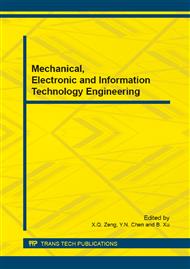[1]
R. M. Measures, Laser Remote Sensing, Fundamentals and Applications, Krieger, Malabar Florida, (1992).
Google Scholar
[2]
D. Sakaizawa, C. Nagasawa, T. Nagai, M. Abo, Y. Shibata, M. Nakazato, T. Sakai, Development of a 1. 6μm differential absorption lidar with a quasi-phase-matching optical parametric oscillator and photon-counting detector for the vertical CO2 profile, Appl. Opt. 48(2009).
DOI: 10.1364/ao.48.000748
Google Scholar
[3]
D. Sakaizawa, M. Nakajima, Y. Sawa, H. Matsueda, S. Kawakami, Ground-based demonstration of a CO2 remote sensor using a 1. 57 μm differential laser absorption spectrometer with direct detection, J. Appl. Remote. Sens. 4(2010) 043548-043548.
DOI: 10.1117/1.3507092
Google Scholar
[4]
M. Imaki, S. Kameyama, Y. Hirano, S. Ueno, D. Sakaizawa, S. Kawakami, M. Nakajima, Laser absorption spectrometer using frequency chirped intensity modulation at 1. 57 μm wavelength for CO2 measurement, Opt. Lett. 37(2012) 2688-2690.
DOI: 10.1364/ol.37.002688
Google Scholar
[5]
X. Sun, J. B. Abshire, Receiver Signal to Noise Ratios for IPDA Lidars Using Sine-wave and Pulsed Laser Modulation and Direct Detections. (2011).
Google Scholar
[6]
X. Sun, J. B. Abshire, Comparison of IPDA lidar receiver sensitivity for coherent detection and for direct detection using sine-wave and pulsed modulation, Opt. Express, 20(2012) 21291-21304.
DOI: 10.1364/oe.20.021291
Google Scholar
[7]
E. T. Scharlemann, Comparison of analysis techniques for multiwavelength DIAL, In Society of Photo-Optical Instrumentation Engineers (SPIE) Conference Series, 3127(1997) 275-285.
Google Scholar
[8]
N. Menyuk, D. K. Killinger, Assessment of relative error sources in IR DIAL measurement accuracy, Appl. Opt. 22(1983) 2690-2698.
DOI: 10.1364/ao.22.002690
Google Scholar
[9]
W. B. Grant, A. M. Brothers, J. R. Bogan, Differential absorption lidar signal averaging, Appl. Opt. 27(1988) 1934-(1938).
DOI: 10.1364/ao.27.001934
Google Scholar
[10]
R. T. Menzies, G. D. Spiers, J. Jacob, CO2 Mixing Ratio Retrievals from JPL Airborne Laser Absorption Spectrometer Flight Campaigns in 2009-(2010).
Google Scholar
[11]
G. J. Koch, J. Y. Beyon, F. Gibert, B. W. Barnes, S. Ismail, M. Petros, P. J. Petzar, J. Yu, E. A. Modlin, K. J. Davis, U. N. Singh, Side-line tunable laser transmitter for differential absorption lidar measurements of CO2: design and application to atmospheric measurements, Appl. Opt. 47(2008).
DOI: 10.1364/ao.47.000944
Google Scholar


